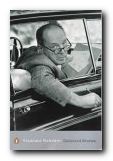a critical examination of Nabokov’s collected stories
 The development of his conversational narrative voice takes a further step forward in ‘The Leonardo’ (July 1933). However, in this instance comes close to becoming irritating because it is coupled to an uncomfortable sense of unreality which pervades the story. Nabokov even begins the piece by rather self-consciously assembling his scenery: ‘Here comes the ovate little poplar, all punctuated with April greenery, and takes its stand where told, namely by the tall brick wall’ (RB,p.11).
The development of his conversational narrative voice takes a further step forward in ‘The Leonardo’ (July 1933). However, in this instance comes close to becoming irritating because it is coupled to an uncomfortable sense of unreality which pervades the story. Nabokov even begins the piece by rather self-consciously assembling his scenery: ‘Here comes the ovate little poplar, all punctuated with April greenery, and takes its stand where told, namely by the tall brick wall’ (RB,p.11).
The story concerns two German thugs, Gustav and Anton, who menace their neighbour Romantovski because he is independent and an individualist who likes books and reading late at night. He is sensitive and fragile, and this incites their moronic desire to do him harm. Eventually they pick a fight with him then murder him. It is then revealed by the police that he was in fact an ex-criminal and a forger – and the narrator ‘confesses’ that he to is surprised by this information: ‘My poor Romantovski! … I believed, let me confess, that you were a remarkable poet whom poverty obliged to dwell in that sinister district’ (p.23).
This is another variation in ‘surprising reader expectation’ rather in the same manner as the sobbing passenger turns out not to be guilty in The Passenger. However, for an author to conceal information and then pretend to be surprised when he reveals it is rather a cheap trick to pull on his readers. It even undermines to a certain extent the serious intent of the story – which is to expose the vulgarity, mindlessness, and the potential danger lurking in those who are intolerant of individualism. The story was, after all, written in the very year that Hitler seized power in Germany.
The elements of unreality and comic-strip stylisation which Nabokov employs certainly underscore the violent atmosphere of the story. The two thugs are described as
‘Gigantic, imperiously reeking of sweat and beer, with beefy voices and senseless speeches, with faecal matter replacing the human brain, they provoke a tremor of ignoble fear’ (p.16)
This was a manner which he was to deploy in the more extended study of violence An Invitation to a Beheading two years later. But it is an approach which does not fit easily with the demand for regularity of tone in the short story.
Nevertheless, the flexibility of the narrative voice is remarkably extended. It is essentially conducted in the first person mode (‘My poor Romantovski’) but most of the time the narrator gives information omnisciently in the third. There are the usual unannounced switches into his characters’ points of view, some interior monologue, and he also passes occasionally into use of the impersonal ‘one’ in order to detach himself – ‘no matter how quietly one advanced towards his door, his light went out instantly’ (p.17).
This device also has the effect of drawing the reader into complicity. The narrator also apostrophises his own creations, speaks directly to the reader, and sometimes gives voice to the voiceless: ‘His long wrists protruded [from a jacket] with a kind of annoying and nonsensical obviousness (‘here we are: what should we do?’)’ (p.14)
Perhaps his most successful effect in this respect is to use the first person plural to indicate the lack of individuality and imagination in his two thugs who are infuriated by their inability to understand Romantovski: ‘the trouble is that we just cannot put our finger on the difference’ (p.18).
These are all devices which he was to develop and use more successfully elsewhere, but their cumulative effect in ‘The Leonardo’ borders on an embarrassing ‘knowingness’ in his narrative which leaves the reader feeling uncomfortable.
© Roy Johnson 2005
![]() Vladimir Nabokov: The Collected Stories – Amazon UK
Vladimir Nabokov: The Collected Stories – Amazon UK
![]() Vladimir Nabokov: The Collected Stories – Amazon US
Vladimir Nabokov: The Collected Stories – Amazon US
Vladimir Nabokov web links
Vladimir Nabokov greatest works
Vladimir Nabokov criticism
Vladimir Nabokov life and works